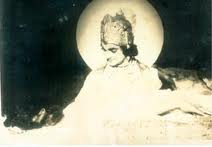Salabega, the son of the Muslim warrior Lalbeg who served under Raja Man Singh in the Mogul army, was born on September 16, 1592 (Radhashtami), in Cuttack near Lal Beg Fort. Lalbeg had kidnapped and married a beautiful Brahmin widow named Lalita, who was taking a bath in the village pond in Danda Mukundpur near Pipili. Despite her forced conversion to Islam, Lalita continued to worship Lord Jagannatha and instilled a strong sense of bhakti in her son.
In 1607, Lalbeg was appointed Subadar of Bengal by Jahangir and called his son to fight alongside him against the Afghans who had rebelled against the Delhi sultanate. During one of these battles, Lalbeg was killed and Salabega was seriously wounded. His condition worsened as infection set in, and his mother called a Hindu sadhu named Bala Mukunda, who chanted the maha mantra and applied holy vibhuti (ashes) to Salabega’s forehead. Miraculously, Salabega’s health was restored, deepening his devotion to Sri Jagannatha.
Salabega’s increasing devotion to Lord Jagannatha made him unpopular among the Muslims, leading to his expulsion from his home and deprivation of all rights. He decided to walk to Puri, but upon arrival, he was not allowed to enter Lord Jagannatha’s temple and was refused shelter by any Matha or Hindu household. He built a small hut made of Tala palm leaves at Balagandi on Grand Road, from where he waited for the chariots during the Ratha Yatra festival. To everyone’s amazement, the chariots of Lord Jagannatha, Balabhadra, and Subhadra stopped in front of his hut, only moving after Salabega pulled the ropes of the chariot.
When Mirja Ahmed Beg, the Subadar of Cuttack, came to attack the Jagannatha temple in Puri, Salabega averted the attack by pleading with him. King Narasimha Deva, grateful for Salabega’s intervention, granted him permission to build a permanent residence, and people from all over India began to visit his Matha. His mother, Lalita, also came to live with him in Puri until her death, after which Salabega faced opposition from temple priests who attacked his Matha when he tried to cremate her at Svargadvara.
Salabega then traveled to Vrindavana but returned to Orissa to be in Puri for the Ratha Yatra. During his journey, he fell ill and prayed to Jagannatha to wait for him. In 1646, during the Ratha Yatra, Lord Jagannatha’s chariot stopped at Balagandi and would not move until Salabega arrived and offered his homage. King Narasimha ordered that Salabega be allowed to enter the temple, but the priests refused. Salabega remained in Puri for the rest of his life and passed away in 1646. His body miraculously turned into a heap of fragrant flowers.
Salabega’s Samadhi is situated in Balagandi, near the Balagandi Chata Matha of the Ramanandi Sampradaya. Every year during the Ratha Yatra, Jagannatha’s chariot stops at his Samadhi. Salabega wrote at least 150 songs on Jagannatha, Radha Krishna, Shiva, and Maa Mangala, with “Ahe Nila Saila” being the most famous.
Lessons to Be Learned
- Faith and Devotion Transcend Boundaries: Salabega’s devotion to Lord Jagannatha highlights that true faith and devotion transcend religious and social boundaries. Despite being born to a Muslim father and facing societal opposition, his unwavering devotion earned him divine favor.
- Divine Intervention: Salabega’s life demonstrates that sincere prayers and devotion can invoke divine intervention. His miraculous healing and the stopping of Jagannatha’s chariot in front of his hut during Ratha Yatra are testimonies to this.
- Unity in Devotion: Salabega’s story emphasizes the importance of unity in devotion. His life and works are celebrated by people from various backgrounds, reflecting the universal appeal of his devotion and teachings.
- Endurance in the Face of Adversity: Despite facing numerous challenges, including expulsion and opposition, Salabega remained steadfast in his faith. His endurance and resilience are inspiring examples of unwavering devotion.
Quotes from Scriptures and Srila Prabhupada’s Books
Srimad Bhagavatam: “Even if one commits the most abominable action, if he is engaged in devotional service, he is to be considered saintly because he is properly situated.”
- Bhagavad Gita 9.30
Caitanya Caritamrita: “Pure love of God is so spiritually potent that simply by hearing the holy name, one is purified.”
- Caitanya Caritamrita, Madhya 15.108
Srila Prabhupada: “A devotee’s position is unique. His service is uninterrupted and free from any material motivation. Such a pure devotee of the Lord can never be vanquished.”
- Bhagavad Gita 9.31 (Purport)
Conclusion
Salabega’s life is a testament to the power of unwavering faith and devotion. Despite facing numerous challenges and societal opposition, his devotion to Lord Jagannatha remained steadfast. His life and works continue to inspire devotees and reflect the universal appeal of sincere devotion. Reflecting on Salabega’s story and the teachings from scriptures and Srila Prabhupada’s books can deepen one’s faith and inspire a dedicated spiritual life.



